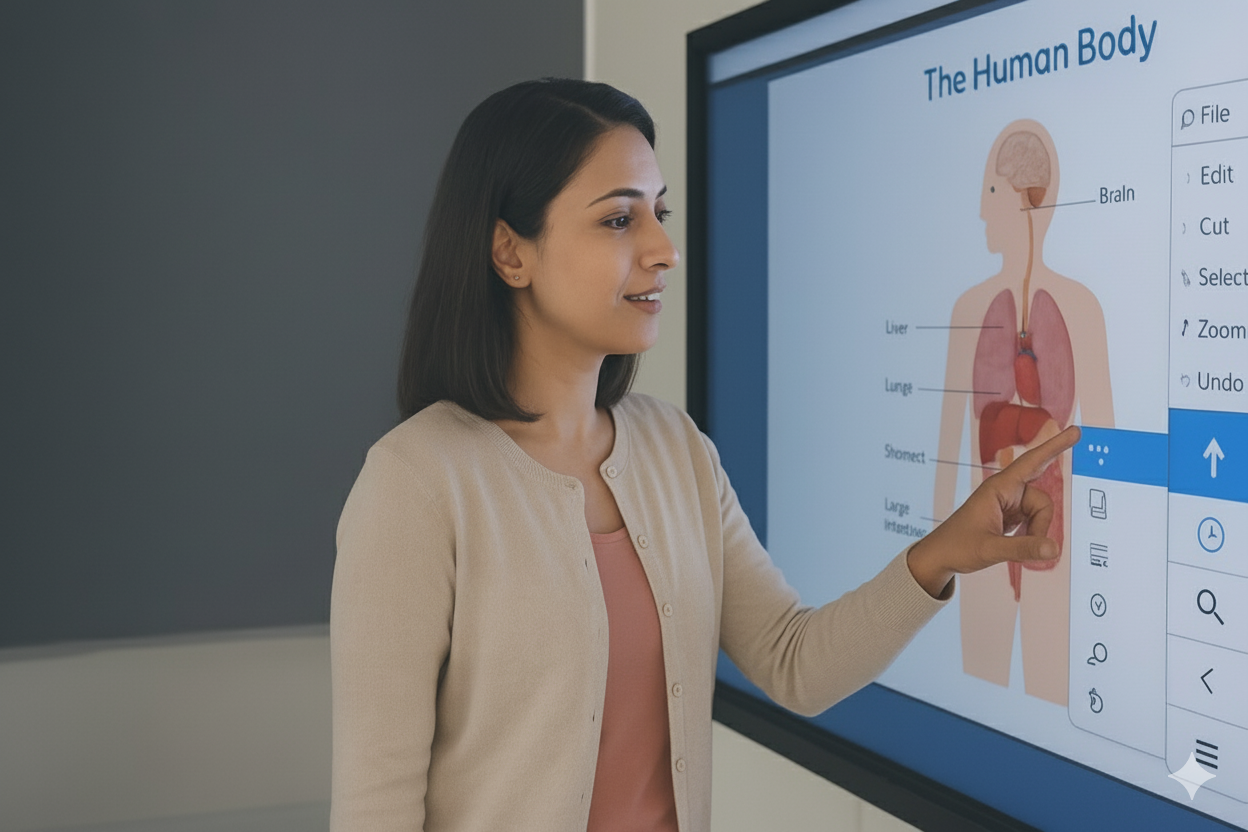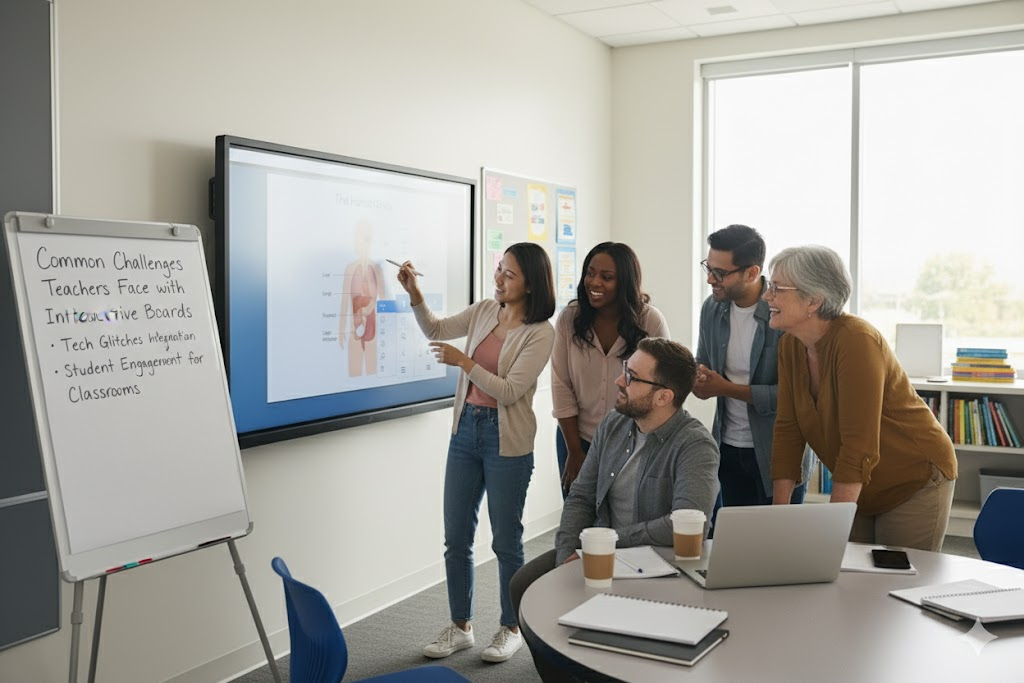Common Challenges Teachers Face with Interactive Boards for Classrooms

Public and private schools across India are steadily adopting interactive boards for classrooms, driven by technology that’s transforming how lessons are taught and learned. These tools bring efficiency, engagement, and flexibility to modern education. However, using smart technology isn’t always as simple as it sounds. Even the most tech-savvy teachers face occasional glitches or moments of uncertainty.
Most educators genuinely want to make the most of a digital classroom, yet the technology itself or sometimes the way it’s introduced can make things tricky. That’s why this blog explores some of the most common challenges teachers face while using interactive boards and how they can overcome them with confidence. Understanding these challenges helps schools offer better support and helps teachers feel more comfortable embracing new tools.
How to Address Challenges When Using Interactive Boards in Classrooms
1. Technical Difficulties in the Classroom
Almost every teacher who’s used technology in class knows how unpredictable it can be. No matter how advanced your interactive boards for classrooms are, things go wrong sometimes — a frozen screen, lagging software, or a sudden loss of connection. And when it happens mid-lesson, it can completely break your rhythm and pull students’ attention away from learning.
How to Overcome It:
- Make sure the school has a dependable technical support system, whether it’s an in-house IT team or help from the vendor.
- Keep things running smoothly by scheduling regular checkups and software updates.
- When buying, go for boards with stable hardware and an easy-to-use interface. They’re less likely to give you trouble in the middle of class.
2. Adapting Lessons for a Digital Classroom
Shifting from a regular whiteboard to an interactive board can feel like a big change. Teachers used to traditional methods suddenly have a whole new world of features in a digital classroom — videos, slides, annotations, interactive quizzes, and more. Figuring out how to use them all takes time and patience. Some teachers end up sticking to basic functions, not because they don’t care, but because the tech feels overwhelming at first.
How to Overcome It:
- Start with small steps. Add a few interactive touches at a time, like circling key terms or showing short clips.
- Use lesson templates or pre-made materials for smart classrooms as they make planning easier and spark ideas.
- Watch other teachers who use interactive boards confidently. You’ll pick up small tricks that make a big difference.
3. Managing Student Engagement
There’s no doubt that interactive boards for classrooms can make lessons more lively. But with excitement also comes distraction. Students may gather too close to the board, get caught up in the touch features, or lose focus altogether. It’s a fine line between engagement and chaos and this is something every teacher learns to balance with time.
How to Overcome It:
- Set a few ground rules early on. Let students know when and how they can interact with the board.
- Use interactivity with purpose. Don’t fill every moment with digital features. Choose moments that enhance the lesson.
- Let students take part from their seats using connected devices, so everyone stays included without crowding around.
4. Overcoming Confidence and Comfort Barriers

Not all teachers feel equally confident about technology and that’s completely okay. Some worry they’ll press the wrong button in front of a class or that something will break down mid-topic. This hesitation often means the smart classroom tools don’t get used as much as they could, even though the potential is huge.
How to Overcome It:
- Encourage a classroom culture where it’s fine to make mistakes even teachers are learning.
- Gather educators for informal peer support or quick practice sessions. It’s easier to try something new when you’re not alone.
- Celebrate small successes, like when a student solves a problem on the board or when a lesson runs smoothly. These moments slowly build trust and confidence.
5. Compatibility and Accessibility Issues
There’s a wide range of interactive boards for classrooms available now, but not all of them play nicely with a school’s existing setup. Sometimes the hardware doesn’t sync well with certain apps, or files refuse to open during class. On top of that, teachers need to ensure every student, including those with special learning needs, can participate comfortably.
How to Overcome It:
- Pick boards and software that work with multiple devices and file types. Flexibility matters more than fancy features.
- Test your content beforehand. It takes just a few minutes and saves you from awkward pauses during class.
- Use accessibility options like text-to-speech, larger fonts, or high-contrast modes to make lessons inclusive for everyone.
6. Maximizing ROI in a Smart Classroom
Even after investing in good equipment, some schools don’t get the results they expect from their interactive boards for classrooms. Often, it’s not about the technology itself but how consistently it’s used. Without regular practice or proper planning, the board ends up being just another screen instead of a real teaching aid.
How to Overcome It:
- Encourage all teachers to use interactive boards regularly, not just during special lessons.
- Hold short review sessions now and then to see what’s working and where improvements can be made.
- Focus on how the technology supports actual education goals which include both teaching and learning.
Conclusion
Interactive boards for classrooms are powerful tools, but they come with challenges. Technical glitches, attention management, confidence barriers, and feature overload are common. Teachers in smart classrooms face them regularly.
The good news is that all these challenges can be managed. Reliable equipment, gradual adoption, peer support, and thoughtful planning make a huge difference. Teachers who feel prepared use the board more effectively. Students benefit. Lessons become more engaging. And technology becomes a partner, not a hurdle.
With patience, experimentation, and support, a digital classroom can transform teaching. The board stops being intimidating and starts becoming a vital part of the learning process.
Curious about how interactive boards can transform your classroom? Learn more about smart classroom solutions here and explore tools that make teaching easier and more engaging.
Foziya Abuwala
Share
Step Into the future of
Education with Roombr

















